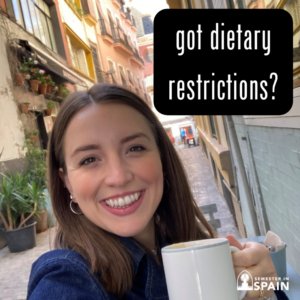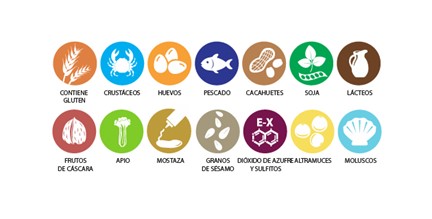
As an individual who is allergic to gluten and dairy, as well as someone who has had numerous bad food experiences internationally, the thought of being able to safely eat for a semester was a genuine fear when I was a student in 2019. However, I was relieved upon arriving in Sevilla, that not only was my host family able to accommodate my needs, while not sacrificing trying authentic Spanish cuisine, I was able to find restaurant menus clearly marked with the allergens that each dish contained. You may think, “Well that was back in 2019… Has anything changed?” Thankfully, I was just in Spain in March (2023), and I had another great experience free of allergic reactions and bad food experiences.
As mentioned, most restaurants either have the allergens clearly marked on their menus (cartas) or you can ask for an allergen menu (carta de alérgenos) with the items clearly marked. Whatever symbol you see next to the dish listed on the menu means that that specific dish contains that pictured allergen (i.e., if there is a wheat symbol next to pan, then the pan contains wheat/gluten; see picture of the symbols below). Do keep an eye out for paella as some restaurants put bouillon cubes in their broths that do contain gluten (always ask before ordering; however, the restaurants that will be mentioned in Part 2 will be safe). Additionally, keep an eye out for aioli and mayonnaise-containing/based items because some restaurants add milk to them (again, always ask before ordering).
Some more pro tips:
- Always tell the restaurant your allergen when ordering, even though the menu items are marked, just for an extra measure of safety.
- If you have a dairy intolerance or allergy, rest assured that Spaniards cook majority of their foods (not including bakery items) in extra virgin olive oil, as Spain is the largest producer and exporter of this oil and can’t even imagine using butter to cook potatoes.
- Spain doesn’t use the verbiage dairy-free on packaging, they say sin lactosa. If you ever see something marked sin lactosa, that doesn’t necessarily mean it’s fully dairy-free, as lactose-free items may still contain dairy products/proteins. However, there are many items that are marked lactose-free that indeed are dairy-free; just be careful to order a gelato that is vegan if you truly are allergic to dairy (see heladerías with flavors in Part 2). See how to express that you are allergic to dairy (rather than lactose-free) below.
- To express your allergy at a restaurant, simply say “Soy alérgico/a a…”, and then insert the name of each one of the items that you are allergic to (see chart below):
- The one exception to this rule is how you would express if you were gluten-free/celiac. In this case, say “Soy celiaco/a.”
- English translation of the allergens listed below (in the order of the chart; from left to right): Gluten/Wheat, Crustaceans, Eggs, Fish, Peanuts, Soy, Dairy Products, Tree Nuts, Celery, Mustard, Sesame Seeds, Sulfites and Sulfur Dioxide, Lupin/Lupini Beans, Mollusks
- For those with a shellfish allergy, note that in Spain, crustaceans and mollusks are noted with separate symbols. For those with a nut allergy, note that peanuts and tree nuts have separate symbols.
- While these are the standard allergen colors/symbols, some restaurants use different colors and symbols, so always double-check each menu’s given chart before ordering.
Click here for an additional resource for how to order both in Spain and while traveling around Europe for various dietary restrictions.
Keep an eye out for Part 2 that will give recommendations for restaurantes, heladerías, pastelerías y más!






